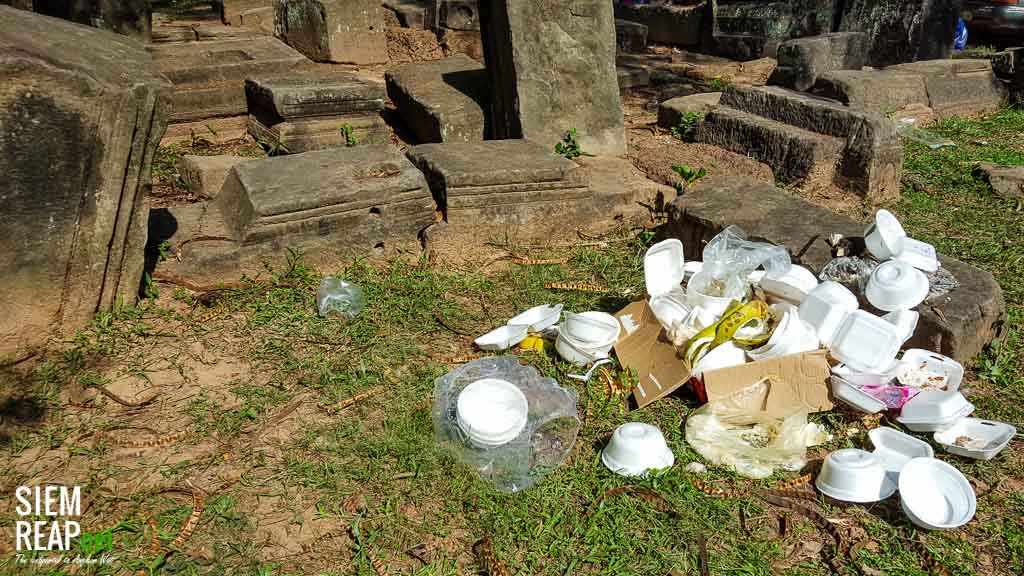
Angkor Archaeological Park is by far the most popular tourist destination in Cambodia, and perhaps in all of Southeast Asia. It was once the largest city in the world, and the remaining historical significance of the park’s network of ancient ruins has earned it UNESCO World Heritage site status. It’s easy to perceive the park as a massive tourist attraction due to the high number of visitors each day. However, it’s actually an active spiritual site for Buddhists. It’s also home to more than 130,000 inhabitants, many of whom can trace their ancestry back to families who lived there during the Khmer Empire between the 9th and 15th centuries.
For these reasons, it’s important to understand the Angkor Visitor Code of Conduct before arriving in Siem Reap. The Code of Conduct is easy to understand, and following it will improve your experience during your visit to the park. It will also help preserve the historic ruins and ensure that the active spiritual practitioners of the park are not offended or disturbed by your actions.
The Angkor Visitor Code of Conduct was developed by the APSARA National Authority, which has been responsible for the conservation and restoration of Angkor Archaeological Park since 1995. The Authority’s main goal is “to harmonize tourist experiences with public safety and respect towards our community”. The guide was developed through the collaboration of the local Angkor community, visitors, tour guides, and the restoration teams.
Dress Code at Angkor
Respecting Buddhist culture and customs is essential when visiting Angkor. In this conservative culture, wearing revealing clothes like shorts, tank tops, or skirts above the knees is seen as highly disrespectful. Additionally, it’s best to avoid showing bare shoulders.
To ensure a respectful visit, it’s strongly recommended to dress modestly, especially since Angkor is often frequented by Buddhist monks engaged in spiritual activities.
Monument Preservation at Angkor
Angkor’s ruins show the effect that time and weather can have on magnificent architecture. Human foot traffic and touching of the ruins’ surfaces accelerates the process of degradation. With thousands of people visiting Angkor Archaeological Park each day, the effects are difficult to prevent.
To minimize your impact while visiting the park, it’s strongly advised to not:
- Touch carvings;
- Sit on fragile structures;
- Lean on temple structures;
- Move or take archaeological artifacts;
- Leave graffiti on walls;
- Wear backpacks, use umbrellas with sharp tips, use tripods, or wear high heels while inside temples;
Noise Control at Sacred Sites
Since it’s an active spiritual site, it’s considered rude to be loud in any way. Therefore, it’s important to talk quietly and respectfully. Yelling or making a lot of noise disturbs other visitors and the temples’ spiritual practitioners.
Be Mindful of Restricted Areas
While exploring Angkor, it’s important to note that certain areas are off-limits to visitors. This is done to safeguard locations undergoing restoration or to ensure the safety of visitors.
Please show mindfulness and respect by adhering to posted signs that indicate restricted areas. It’s crucial that visitors never go beyond these signs under any circumstances.
Smoking and Littering are Strictly Prohibited
Angkor is a member of the World Health Organization, and has been a smoke-free historic site since 2012. Smoking cigarettes within the park disturbs others and increases the risk of starting brush fires. Needless to say, littering within the park is not allowed. Trash cans are established throughout the park, and backpacks and purses can also be used to carry out trash. If you see litter, be a custodian of the park and of the environment, and pick it up to improve the experience for your fellow visitors.

Buying From Children
In Cambodia, you may encounter children selling items to tourists on the streets. However, it’s important to be aware that buying from these children, offering candy or snacks, or giving them money directly can unintentionally discourage them from attending school.
While the desire to help the less fortunate in Cambodia is understandable, a more effective approach is to contribute to established charities that support education, literacy, and the overall economy of the country. Also read our detailed guide about why you shouldn’t give money to begging children.
Interacting with Monks at Angkor
While Buddhist monks in Cambodia are highly respected, it is not forbidden to speak with them. To ensure a respectful interaction, please be mindful of certain rules:
- If you’d like to take a photo with a monk, kindly ask for permission and respect their decision, even if it’s a no.
- For women, it’s important to maintain a respectful distance from monks, avoiding standing or sitting too close, as this aligns with their way of life.
- Please refrain from touching, hugging, or placing your arm on a monk’s shoulders during photos or at any other time.
Commercial Photography and Drones
If you plan to use professional equipment to film or take pictures for commercial purposes, you must obtain a permit from the APSARA National Authority in advance. Also, drone use within Angkor Archaeological Park is strictly prohibited without written permission obtained ahead of time. Visit www.apsaraauthority.gov.kh for more information on obtaining the appropriate photography, filming, and drone permits.
Resources
- Printable Angkor Visitor Code of Conduct in Chinese (PDF)
- Printable Angkor Visitor Code of Conduct in English (PDF)
- Printable Angkor Visitor Code of Conduct in French (PDF)
- Printable Angkor Visitor Code of Conduct in Japanese (PDF)
- Printable Angkor Visitor Code of Conduct in Khmer (PDF)
- Printable Angkor Visitor Code of Conduct in Korean (PDF)